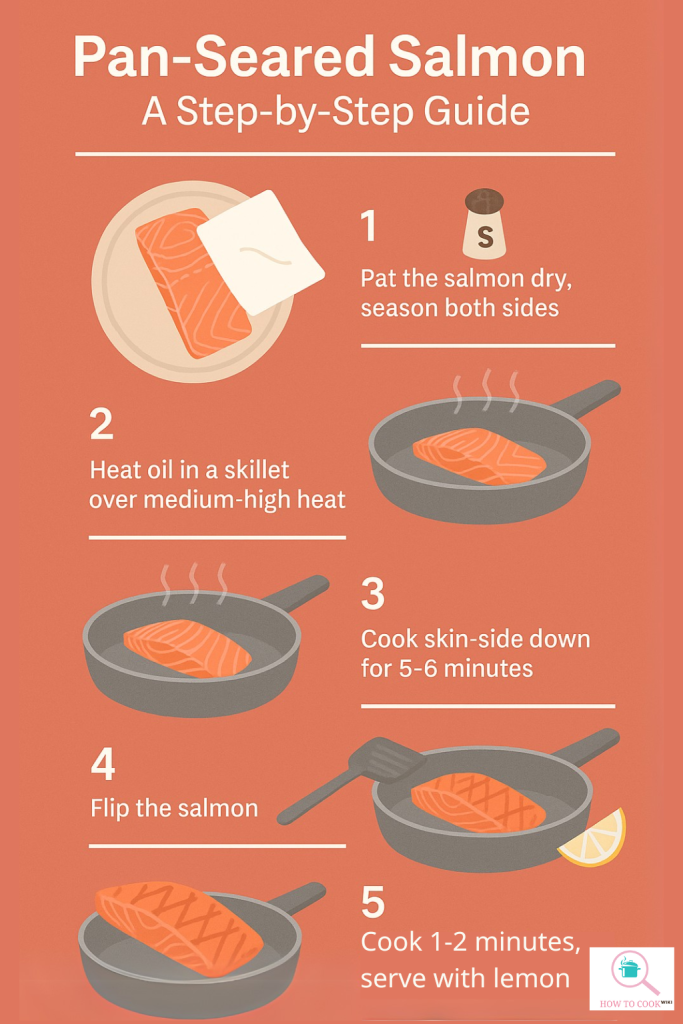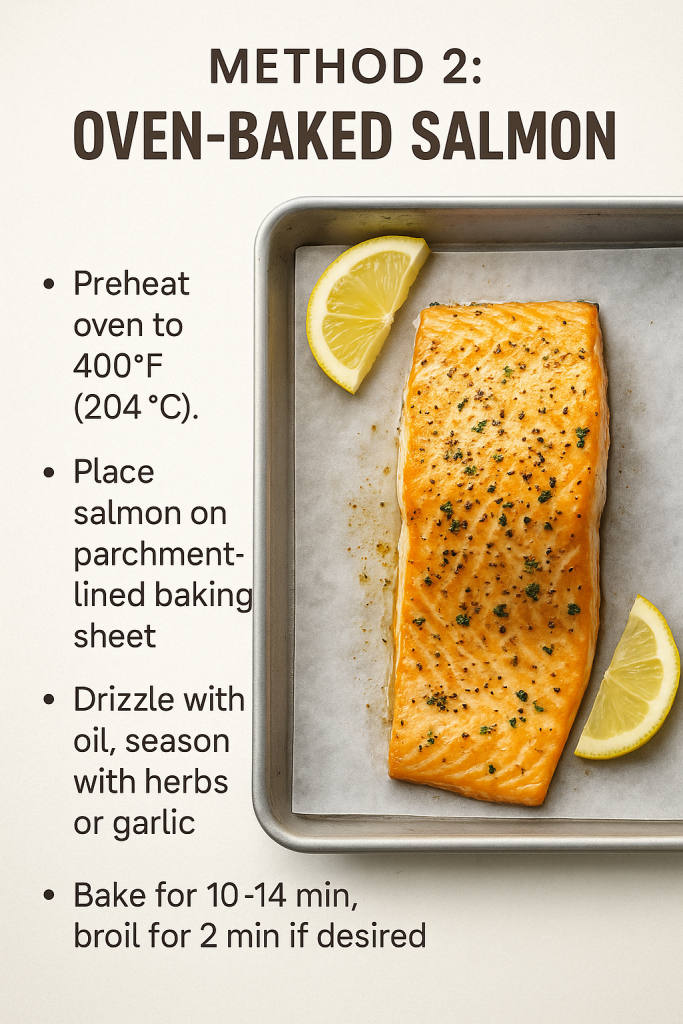Salmon is one of the most delicious and nutrient-rich proteins you can cook — and one of the easiest to mess up. Overcook it and it turns dry and chalky. Undercook it and you risk mushy, raw textures.
The good news? With the right approach, anyone can learn how to cook salmon to flaky, juicy perfection — every time. This guide will walk you through the most popular cooking methods (pan, oven, grill, poach, air fryer), how to choose the right cut, seasoning tips, internal temperature, and common mistakes to avoid.
Why Cook Salmon at Home?
-
Rich in Omega-3s and lean protein
-
Cooks quickly — 10–15 minutes for most methods
-
Versatile: works with bold sauces or simple lemon & herbs
-
Less expensive than restaurant meals
How to Choose Salmon?
Wild vs. Farmed:
-
Wild salmon has firmer texture and deeper flavor.
-
Farmed salmon is milder and more fatty, often cheaper.
Cut Types:
-
Fillets (most common) – cook quickly, great for weeknights
-
Steaks – thicker cuts with bones, better for grilling
-
Whole salmon sides – best for entertaining or meal prep
Skin-on or skinless?
-
Skin-on fillets hold together better during cooking and add flavor when crisped.
👉 Planning to smoke your salmon instead? Learn which varieties work best in our full guide: Best Salmon for Smoking.
Method 1: Pan-Seared Salmon (Crispy Skin!)

Best for: Weeknight meals with restaurant flavor
What you’ll need:
-
Skin-on fillets
-
Olive oil or butter
-
Salt, pepper, lemon wedges
Instructions:
-
Pat salmon dry with paper towels. Season both sides.
-
Heat skillet over medium-high heat and add oil.
-
Place salmon skin-side down and press gently for 10 seconds.
-
Cook skin-side down for 5–6 minutes until skin is crisp and salmon is mostly cooked.
-
Flip and cook 1–2 minutes more.
✅ Pro tip: Use a fish spatula and don’t move it once placed. The fish will release naturally when the crust forms.
Method 2: Oven-Baked Salmon

Best for: Hands-off cooking, meal prep
Instructions:
-
Preheat oven to 400°F (204°C).
-
Place salmon fillets on a parchment-lined baking sheet.
-
Drizzle with oil and season with herbs or garlic.
-
Bake for 10–14 minutes, depending on thickness.
-
Optional: Broil for final 2 minutes for color.
✅ Pro tip: Add sliced lemon or dill under each fillet for infused flavor.
Method 3: Grilled Salmon
Best for: Summer BBQs or smoky flavor
Instructions:
-
Preheat grill to medium-high and oil grates.
-
Rub fillets with oil and seasoning.
-
Place skin-side down, close lid, and grill for 6–8 minutes.
-
Flip carefully and grill 2–3 more minutes.
✅ Pro tip: Use a fish basket or foil packet if you’re nervous about sticking.
Method 4: Poached Salmon
Best for: Delicate texture, light flavor
Instructions:
-
Fill skillet with water or broth, add aromatics (lemon, bay leaf, peppercorn).
-
Bring to a gentle simmer, not a boil.
-
Slide in salmon and simmer uncovered for 10–12 minutes.
-
Remove with slotted spatula.
✅ Pro tip: Great for chilled dishes like salmon salad or brunch.
Method 5: Air-Fried Salmon
Best for: Quick meals, minimal cleanup
Instructions:
-
Preheat air fryer to 390°F (199°C).
-
Rub salmon with oil, salt, and pepper.
-
Air fry for 7–10 minutes, no flipping required.
✅ Pro tip: Add a honey mustard or teriyaki glaze before cooking.
How to Tell When Salmon is Done
-
Internal Temperature:
-
USDA recommends 145°F (63°C)
-
Many chefs prefer 125–130°F (52–54°C) for medium and moist
-
-
Visual Clues:
-
Flesh turns opaque and flakes easily with a fork
-
Albumin (white protein) appears on surface — a sign it’s almost done
-
Top Seasoning Ideas
-
Lemon + Dill: Classic and light
-
Honey Garlic Glaze: Sweet + savory
-
Teriyaki Marinade: Great for grilling
-
Blackened Cajun Rub: Bold flavor, pairs well with creamy sauces
-
Maple Soy: Sweet and salty for roasted salmon
Common Mistakes to Avoid
❌ Overcooking:
Salmon cooks fast — always check doneness early.
❌ Cooking cold salmon straight from fridge:
Let it sit out for 15 minutes before cooking for even heat.
❌ Using high heat with no oil:
Salmon can stick or burn — use oil and moderate heat.
❌ Not drying the salmon:
Moisture = steamed fish instead of seared.
❌ Flipping too often:
Let it sear undisturbed before flipping.
Best Side Dishes with Salmon
-
Roasted asparagus or green beans
-
Garlic mashed potatoes
-
Quinoa or wild rice
-
Cucumber salad
-
Lemon herb couscous
-
Roasted sweet potatoes
FAQs: How to Cook Salmon
Q: Do I need to remove the skin before cooking?
A: No — cook skin-on for better structure and crispiness. You can peel it off after cooking if preferred.
Q: Can I use frozen salmon?
A: Yes! Thaw overnight in the fridge or under cold water. For baking, you can even cook frozen fillets directly — just extend the time by 5–10 minutes.
Q: How long does cooked salmon last?
A: Store in an airtight container for up to 3 days in the fridge.
Q: Can I eat salmon medium-rare?
A: Yes — many chefs prefer salmon at 125–130°F for the best texture.
Nutrition Info (per 6 oz cooked portion)
-
Calories: 367
-
Protein: 34g
-
Fat: 22g (mostly healthy omega-3s)
-
Carbs: 0g
-
Selenium, B12, Vitamin D – excellent sources
Final Thoughts
Salmon doesn’t require complex techniques or expensive gear — just smart timing and good seasoning. Whether you pan-sear for a weeknight dinner or bake a whole fillet for guests, knowing how to cook salmon gives you a go-to meal that’s fast, healthy, and always impressive.

Randolph Castillo is the owner of a restaurant barbecue and pub. He also has his own cooking blog, where he specializes in baked goods. Randolph is an experienced chef and loves to review different grills and kitchen tools. He is always looking for ways to improve his cooking skills.

